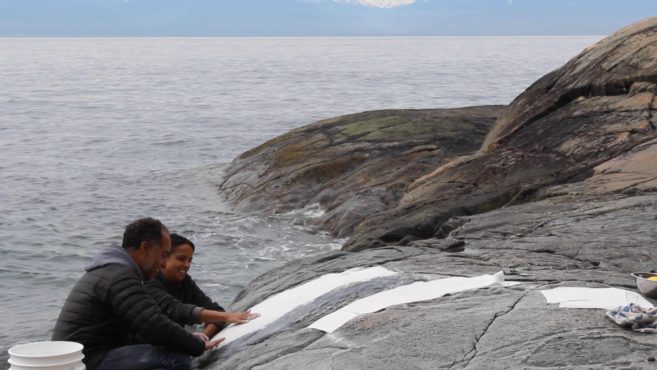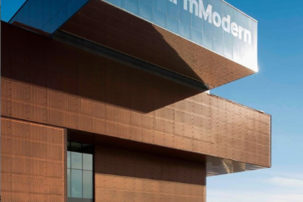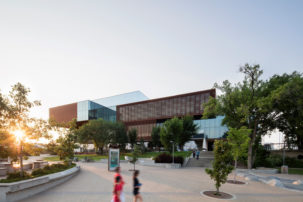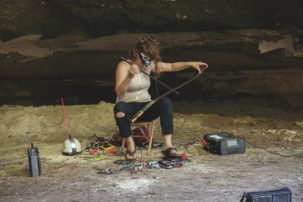Some people in Saskatoon are worried that recent changes at the Remai Modern, initiated by city administration, threaten to reduce a “world-class” art museum to an oversized venue for mediocre local and wildlife art. I disagree. The shakeup has little to do with art. Instead, it is about accountability and transparency in management and governance.
Many people, locally and nationally, were surprised when Gregory Burke, executive director and CEO of the Remai Modern Art Gallery of Saskatchewan, announced his resignation in December 2018 to take up the directorship of the Auckland Art Gallery in his native New Zealand. After all, Burke had just been credited with leading an extraordinary successful first year of operations at the Remai Modern—one in which the gallery “exceeded its own expectations” by surpassing the goal of 190,000 visitors with a total of 453,176. Officials claimed that 40 per cent of visitors were from out of province—a gratifying figure for those who’d promoted the Remai Modern and its $20-million collection of Picasso prints as a tourist attraction and economic driver. In October 2018, Burke had assured the Saskatoon StarPhoenix that he planned to “stick around for a bit” and “enjoy the fruits” of his labour.
More than two months after Burke’s resignation announcement and two months before his planned departure on March 15, Sandra Guimarães—“Remai Modern’s high-profile Portuguese curator,” as the StarPhoenix referred to her—left her position as director of programs and chief curator, without any announcement or explanation from the gallery.
Then, on February 21, 2019, news sources revealed that at least five of the Remai Modern’s board members, including the board’s entire executive, were not being recommended by Saskatoon City Council to renew their two-year terms, which expire at the end of March. Instead, the names of five new trustees were put forward to take their place. Now it appears that a total of seven board members who served over the past two or more years are slated to depart.
For the moment, let’s leave aside any questions we may harbour about the reported attendance in the Remai’s first year. Recently the first-year attendance was recharacterized as “visits,” not visitors (although the Remai Art Gallery of Saskatchewan Business Plan clearly speaks of visitors). Let’s also ignore that some of the other numbers put forward by the Remai Modern, such as 44,365 patrons at Shift Restaurant and 20,192 items sold in the Art & Design Store, tell us nothing about profits, losses, or the gallery’s overall financial health. The audited financial statements are expected later this year, and these will provide more information.
What’s interesting about the current shakeup are the accusations by departing board members that the board reshuffling is an attempt by the city council to meddle in the gallery’s programming. In a statement to the press, ousted board secretary and artist Alison Norlen claimed that there has been a clash of vision. City councillors, she stated, were opposed to the “strong voices” of some Remai Modern trustees, including her own and that of the board chair, Scott Verity, a KPMG executive. She added, “our high level of experience…is seen as undesirable at this point in the Remai’s progression.”
“They are attempting to interfere with the philosophy of the mandate,” Norlen continued, “including programming and acquisition.” What’s more, “I feel that the city does not understand the concept of modern.”
If this is what the changes are about, a number of questions emerge. How should the city understand the concept of modern, as it is operationalized at the Remai? Do all the departing board members—who, along with Norlen and Verity, include a senior business consultant, another accountant, an investment advisor, a marketing consultant and a kinesiology professor—also possess a superior understanding of “modern?”
If so, how do outgoing board members explain the permanent celebration of Picasso alongside Rirkrit Tiravanija’s recreation of Július Koller’s installation of Ping-Pong tables, in the same space as a “fireside” conversation with the city’s police chief about Indigenous/police relations since the Stonechild Inquiry, the latter being a public program tied to a solo show by Rebecca Belmore? If this is all modern, isn’t everything?
Leaving aside the question of “what is modern?” we might also ask: In what way is the board of the Remai expected to contribute to “the philosophy of the mandate, including programming and acquisitions”?
The mandate of the Remai Modern, as laid out by the City, is as boring as any other museum’s, filled with words like “establish,” “maintain,” “preserve,” “collect,” and “encouraging the development and appreciation”—the kind of mandate that made Stephen Weil’s eyes roll. Although “modern” appears in the gallery’s name and in some descriptions of the gallery, the museum’s vision addresses the “art of our time.” In any case, nowhere under the requested qualifications in either of two calls for trustees found on the city’s website do we find attributes related to the trustees’ knowledge of modern or even contemporary art. Rather, prospective board members are encouraged to possess financial and business experience, contacts in the community, fundraising capabilities and “Indigenous relations experience,” along with a willingness to participate as necessary in the selection and evaluation of directors of the board. In the most recent call, they are also asked to possess sufficient knowledge of governance practices to ensure sound governance of the gallery, as well as knowledge of and attention to budgetary matters to ensure the gallery’s financially sound operation. Over the past two weeks, I have placed calls or sent emails to several city politicians, the City Clerk’s Office, a current board member and an incoming board member, but my inquiries have yielded no further guiding documents for the board.
The City owns the building and will provide the Remai Modern with $5.93 million in annual operating funds in 2019. Saskatoon mayor Charlie Clark, who is no stranger to the gallery, having sat as a city councillor on the board of the Mendel Art Gallery as it transitioned to the Remai Modern, has declined to comment on the reasons for the board turnover. But he did state: “I want to be clear that we’re not interested in getting involved in decisions around programming,” adding that council’s focus “is and will continue to be on the organizational and financial strength of the Remai.”
Then news broke on March 5, 2019, that Burke is being investigated by the Saskatchewan Human Rights Commission on a workplace harassment allegation dating back to the organization’s time as the Mendel Art Gallery. It was also reported that two separate reports on workplace dynamics at the Remai were completed since the Remai opened; one was conducted by the executive coaching firm Logia Consulting, and the other by a newly appointed ombudsperson for the City. The StarPhoenix stated that on February 11, 2019, Verity sent a memo to Remai Modern staff announcing that the board had decided to split the position Burke held into two separate positions, with a chief operating officer to focus on the gallery’s operational side, and a chief executive officer to “handle programming.” According to the StarPhoenix, Verity mentioned both workplace reports and told staff that the board had appointed a human resources officer to implement “recommended workplace improvements.”
On March 8, CBC reported that the City of Saskatoon has acknowledged that “many” Remai Modern employees voiced concerns about the art museum’s workplace to the city’s ombudsperson, Claudia Hemani. According to the CBC, in January 2019, Hemani sent an email to Remai staff on behalf of city manager Jeff Jorgenson, stating: “Thank you again for bringing forward your concerns about various serious matters pertaining to the gallery.” He continued: “The city is doing everything in its power to work with the [Remai board] to [effect] change. The board is obliged to provide a safe and healthy work environment and the city will do everything in its power to ensure that occurs.”
And most recently, on March 10, 2019, Verity issued a five-part statement via Twitter, claiming that Remai trustees “engaged qualified independent third parties” to investigate three formal workplace complaints that had been made under Burke’s tenure, which are separate from the case being investigated by the Human Rights Commission. None of the three complaints, he says, were substantiated by the third party, whom he does not identify. Verity also notes that the Board first engaged an external executive coach in April 2016. “A healthy, welcoming and productive work environment has been, and continues to be, among our highest priorities,” Verity stated. The Board renewed Burke’s contract for a second five-year period in spring 2018. The City hired an ombudsperson in August 2018.
One has to wonder if the Remai Modern board had been concerned with the rate of turnover for managerial, creative and administrative staff under Burke’s leadership. Some of the many positions that turned over, a few more than once, include Director of Development, Development Manager, Learning & Engagement Manager, Communications Manager, Design Coordinator, Editor & Publications Coordinator, Accounting Manager, and of course, Chief Curator. Such turnover is costly—some individuals relocated for their Remai jobs from places like Toronto, Montreal, and even Abu Dhabi, but stayed in Saskatoon for less than a year. The board may have wondered if the frequent staff turnover indicated an underlying problem with employee morale, and they may have wondered about the cause.
Then again, they may not have.
The insistence of some outgoing trustees that the current shakeup is about a clash of programming vision between the city and the Remai board is, in my opinion, a red herring. In terms of programming, the Remai Modern is no more and no less “modern” than the Mendel was. It is a contemporary art gallery housed in a much bigger building than the Mendel, with a much bigger budget, and it is building a much bigger collection. As the StarPhoenix reported back in 2016, it spends a lot more money on staff travel under “unclear” justifications than the Mendel ever did.
What really changed when the Mendel folded and the Remai Modern took its place was the vision the gallery had of its role and of the public it serves. The Mendel was established for the people of Saskatoon, and, while far from perfect, took this role seriously. When discussion of the new gallery building began, the vision being discussed was also for this public. But as time went on, as donations accrued, and as design plans were drawn up, this vision began to shift into something more grandiose: the idea of being “world-class” and putting Saskatoon “on the global map of culture.” Burke, once hired as CEO, translated this into a personal, highly Modernist mission. “Our goal is to be a direction-setting museum. We want to be right at the arrowhead of the development, discussions and discourse around art itself,” he told the Globe and Mail, explaining, “I…had the opportunity to start a new museum from the ground up, to really put the DNA into its programmatic philosophy. And that’s one thing that captured me to come here and do this.”
You would be forgiven for wincing at the talk of arrowheads and a white man inserting the DNA into such a major cultural project during this time of “reconciliation.” Yet the language is revealing. What’s really modern at the Remai Modern is not a particular focus on modern art, nor even the organization’s claim that a guiding principle is to be “committed to interrogating the idea of ‘modern’ from multiple cultural, historical and contemporary positions” (a principle that serves mainly to justify the gallery’s focus on contemporary art while maintaining an ongoing engagement of the Picasso prints). Rather, it’s the very notion of “cutting edge,” with its universalist and colonizing assumptions, that has given the Remai Modern its modern whiff. It’s the Remai calling itself a “thought leader”—a term Burke has used repeatedly to describe the work of the gallery and thereby himself. It’s responding to community pressure to Indigenize the gallery by hiring an adjunct curator with a full-time position in Ontario, permitting Burke to claim he has appointed an Indigenous curator, while avoiding having to work with one on a daily basis. It’s all this, topped off with what, by all accounts here on the ground in Saskatoon, is an old school command-and-control management style that sees employees as expendable “human resources.”
The Remai Modern should pay more than passing respect to the necessity for public accountability and transparency in its mission and operations, which includes: providing a supportive workplace for all employees, in which their ideas and competencies are acknowledged, respected and encouraged; breaking down attendance statistics into meaningful data for analysis, rather than obfuscating with a “visits” figure that multiplies—by who knows how much—unique visitations; and making available the agendas and minutes of board meetings for public inspection on the City of Saskatoon website, as do other statuary boards and controlled corporations of the City, such as the Saskatoon Public Library and the Board of Police Commissioners.
The CBC reports that the Remai’s staff have been offered “ongoing product conflict training sessions, as well as DiSC (Dominance, Influence, Steadiness and Conscientiousness) training to help build better workplace relationships.” This is great, but more is needed.
If the Remai Modern wants to live up to its stated principles of becoming “a platform for rethinking the role of the 21st-century art museum,” “a leader in developing new models for sharing knowledge and engaging diverse communities,” and “a leading centre for contemporary Indigenous art and discourse,” not only will trustees require ongoing governance training, but the board and staff must also be diversified and Indigenized in ways that move beyond the tokenistic. The Remai needs to rethink its management structure: hierarchies should be significantly flattened, and silos of responsibility abolished to the greatest degree possible. At the same time, the educator’s roles should be elevated, by which I mean the Remai must hire individuals with backgrounds in education and community development for the most senior, strategic positions.
Some of this will be difficult to achieve in the gallery’s unionized environment, but I believe there is a willingness among Remai staff to rethink the museum’s role. It is their dedication and persistence that has contributed to whatever success the organization has achieved so far. Which is to say, Burke did not start the Remai “from the ground up”: this tabula rasa narrative discounts not only the elaborate planning for the new building that had been completed before his arrival, along with the substantial financial commitment of Ellen Remai, but also the public and political support for the new building that had been generated by the Mendel Art Gallery, and the input, ideas and labour of dozens and dozens of employees and volunteers. It further discounts the rich cultural ecology of Saskatoon and Saskatchewan, one that has developed over generations of collaboration, exchange and productive conflict between artists, organizations and communities. It is by embedding itself in this ecology and acknowledging that it is but one player among many other vital players that the Remai Modern will succeed.
To keep the Remai’s troubles in perspective, we should recall that it is far from the only art museum facing problems in governance, management, and—let’s face it—“vision.” Helen Molesworth, a curator fired last year from her position at MOCA LA, wrote in the March 2018 issue of ArtForum: “The museum, the Western institution I have dedicated my life to, with its familiar humanist offerings of knowledge and patrimony in the name of empathy and education, is one of the greatest holdouts of the colonialist enterprise. Its fantasies of possession and edification grow more and more wearisome as the years go by.” What’s heartening about the City of Saskatoon’s recent intervention in the Remai Modern is its creation of a plum opportunity to rethink this enterprise.

 The Remai Modern in Saskatoon. Photo: Nic Lehoux via Remai Modern Instagram.
The Remai Modern in Saskatoon. Photo: Nic Lehoux via Remai Modern Instagram.







